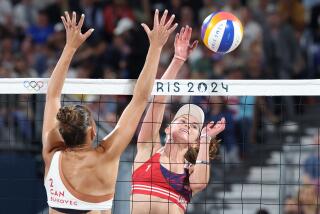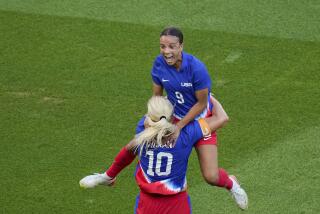Sampras and Raymond Feel Wrath of the Gods
- Share via
Maybe we all missed the thunderbolt, thrown down by an angry Olympian god, that mangled the computer that eventually spat out the name of Pete Sampras--Olympic Draft Dodger--as the fourth-seeded men’s player at this week’s U.S. Open.
Sampras, reigning Wimbledon champion and winner of more Grand Slam singles titles than any man who ever lived, seeded fourth in a tournament he has won four times, more than any man who has played since the Jimmy Connors-John McEnroe era?
Seeded below Gustavo Kuerten and Magnus Norman?
Cosmic payback is a bear. Say no to the Olympics one month, see what happens the next?
The U.S. Open seedings capped a very dumb and embarrassing week for the U.S. Tennis Assn., which made it official Wednesday: The Olympic women’s tennis team it will be sending to Sydney will not include the top-ranked women’s doubles player in the world, Lisa Raymond.
Unlike Sampras, Raymond wanted to compete in the Olympics. Desperately. She took the USTA to arbitration after she was left off a four-woman team of singles players Lindsay Davenport, Venus Williams and Monica Seles and the doubles tandem of Venus and Serena Williams.
Raymond filed a grievance, arguing that she deserved the doubles spot that went to Serena on the basis of her No. 1 world ranking and the fact that Williams had played doubles in only two tournaments in 2000.
Wednesday, her petition was denied, but not before arbitrator Richard Jeydel upbraided the USTA for its bungling of the team selection process. While he was at it, Jeydel also should have pointed to the playing membership of the Women’s Tennis Assn. and the International Tennis Federation, because this was a mess that could have been averted at least three times along the way.
1. The WTA set the groundwork for inevitable controversy when its players voted not to attach tour rankings points to the Olympics, which would have secured six player berths for the United States instead of four. The Assn. of Tennis Professionals voted the other way, which is why the United States is sending six men to Sydney--Andre Agassi, Todd Martin, Michael Chang, Jeff Tarango and the doubles team of Alex O’Brien and Jared Palmer.
Seles lobbied hard to attach points to the Olympic tournament, foreseeing the potential angst a no vote could bring. But she was speaking to a roomful of professional tennis players, so she might as well have been speaking to a wall. Blinded by self-interest, the majority voted against the proposal on the basis that “If she goes to the Olympics and I don’t, I don’t want her getting ranking points unavailable to me.”
It was short-sighted, it was selfish, but, given the membership, it was anything but surprising.
2. Billie Jean King, captain of the U.S. Olympic women’s tennis squad, could have stuck purely to the rankings when selecting the team. She did that with the singles players, choosing the three highest ranked Americans, but veered away when she added Serena as a doubles player.
Selection by rankings would have made it simple: Raymond is ranked No. 1 in doubles, Raymond plays doubles in Sydney.
Simple, yes; easy, no. Venus hinted after Wimbledon last month that she might bypass the Olympics entirely if sister Serena hadn’t been added as her doubles partner. Also, in the real world, as opposed to computer rankings, Venus and Serena are the best women’s doubles team on the planet. They don’t often play together, but they have won the doubles championship in the last three Grand Slam tournaments they have entered.
Raymond might be ranked No. 1, but the question remains: How good would she fare in a world-class field playing with someone besides her regular doubles partner, Australian Rennae Stubbs?
3. The ITF could have given the United States an extra wild-card selection and added Raymond as a fifth member to the U.S. team. Instead, the ITF’s wild-card roster looks like something pulled out of a phone book at random: Amanda Hopmans, Catalina Cristea, Tina Krizan, Alicia Molik, Katarina Srebotnik, Miroslava Vavrinec . . .
It comes as no help to Raymond now, but there was a better way.
At the very least, there were three.
ONE VOTE FOR THE AUSSIES
Great Britain swimming Coach Craig Hunter might have just been playing to the crowd, but he told reporters in Australia this week that he believed the Aussies were capable of beating the United States in the Olympic swimming medals standings.
“It will no doubt be between the U.S. and you Australians,” Hunter said, “and as an impartial observer, I would say the depth of the U.S. team is just a little stronger. With a nation of about 255 million, they probably should be stronger than a nation the size of Australia.
“But you guys have got a home advantage, a partisan home crowd and I think you can do anything at the Olympics.
“It isn’t just a partisan home crowd, it’s also a knowledgeable one. It was partisan in Atlanta for the Americans but not knowledgeable. And that can make a world of difference.
“Perhaps in some events you’re not as strong as you’d like to be--[your] women perhaps aren’t as strong as your men or the American women--but it will be a fascinating contest.”
The home-pool advantage can be a big one. Inspired by a raucously supportive crowd at the Sydney International Aquatic Center, Australia’s Ian Thorpe set four world records at the 1999 Pan Pacific Championships.
Hunter said he would be pulling for the Aussies at the Olympics--to a point.
“We’d love to see you do particularly well,” he said. “But not at our expense. We need our share of medals.”
NO GOOOOOOOOOOOOLD?
The United States might have lost the Olympic women’s soccer gold medal Thursday with the announcement of Michelle Akers’ retirement from international soccer.
Mia Hamm and Brandi Chastain got more media, but no player was more important to the United States’ 1999 World Cup triumph than Akers, who was a dominating presence in the central midfield, helping control the tempo of the U.S. attack and often marking the opposition’s top offensive player. She was at her best in the final, completely stifling China’s dangerous goal scorer, forward Sun Wen.
Akers, with 153 appearances and 105 goals for the national squad, was the team’s emotional leader, with younger teammates drawing inspiration from her seemingly perpetual struggle to play through injury and illness. She was also among the team’s most physical players, strong on headers and in the tackle.
Without her intimidating presence in the middle, the United States looks a good deal more vulnerable on defense, which already had been an area of concern. During Akers’ recent injury-related absence from the U.S. team, Lorrie Fair and Nikki Serlenga--both relatively untested at the world level--have been sharing the defensive midfielder position.
A tough assignment for the Americans--in the same first-round group with China and Norway--just became a lot tougher.
‘A’ STANDARD UPDATE
Three athletes who walked away from the U.S. Olympic track and field trials uncertain if they were bound for Sydney or not have cleared up the issue during the last three weeks, achieving the requisite Olympic “A” standard in their respective events.
Finally officially stamping their names onto the U.S. track team are:
* Michael Stember, who placed third at the trials in the men’s 1,500-meter run. Needing the “A” standard of 3 minutes 36.80 seconds, Stember ran 3:35.11 in Monaco. Stember joins Stanford teammate Gabe Jennings and U.S. indoor mile champion Jason Pyrah on the U.S. team.
* Jud Logan, third in the men’s hammer throw at the trials. Needing the “A” standard of 247 feet 8 inches, Logan unleashed a throw of 248-1 in Rudlingen, Switzerland. Logan joins 1996 Olympic silver medalist Lance Deal and Kevin McMahon on the U.S. team.
* Nick Rogers, third in the men’s 5,000 meters at the trials. Aiming for the “A” standard of 13 minutes 29 seconds, he ran 13:18.50 in Heusden, the Netherlands, and joins Adam Goucher and Brad Hauser on the American team.
More to Read
Go beyond the scoreboard
Get the latest on L.A.'s teams in the daily Sports Report newsletter.
You may occasionally receive promotional content from the Los Angeles Times.






